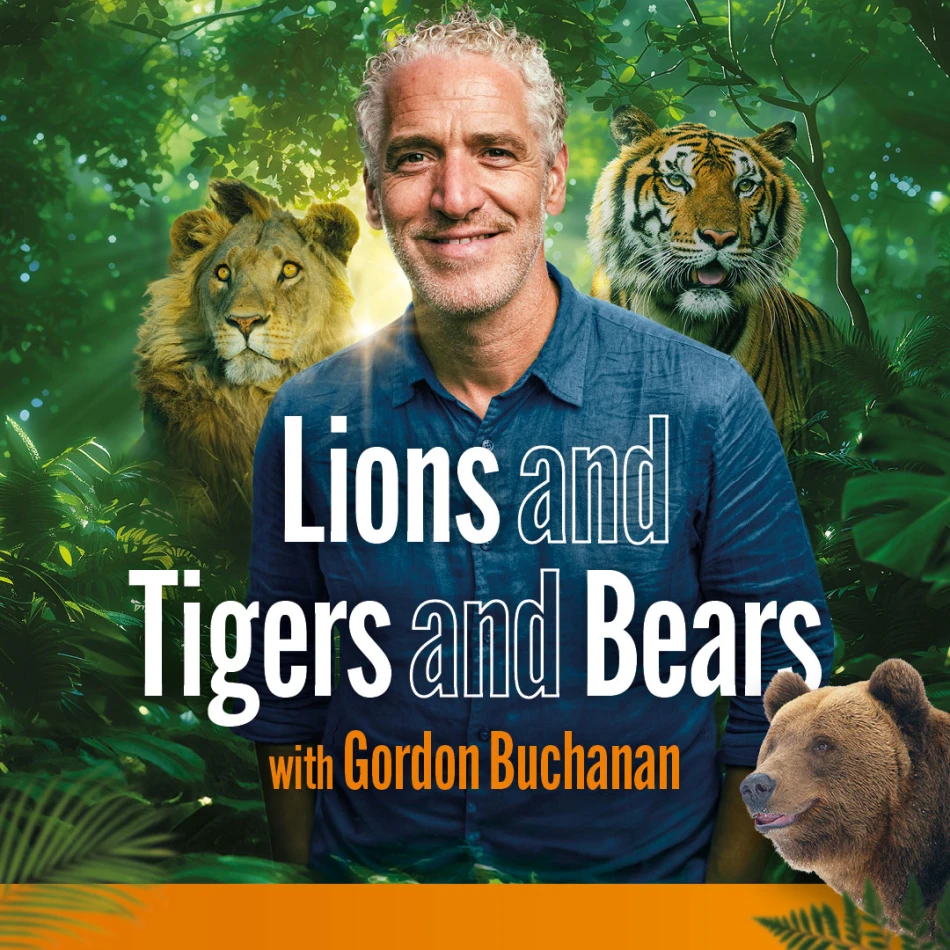“We’ve Got a Primal Fear of Lions and Tigers and Bears… but We Welcome Them into Our Homes” Says Wildlife Filmmaker Gordon Buchanan Ahead of Sharing His Stories on Tyne Theatre Visit

Gordon Buchanan has had more cause than most to exclaim “Oh my!” in a career that’s charted the lives of some of nature’s most charismatic beasts – and now he’s set to share tales of Lions and Tigers and Bears on his biggest ever live tour, stopping by Newcastle's Tyne Theatre & Opera House on Friday 28th March 2025.
Wonderfully well timed, given the hugely successful Wicked cinematic release, Gordon has taken inspiration for his tour from the iconic movie The Wizard Of Oz and the famous line “Lions, and tigers, and bears… Oh my!”
And he’s got a theory why people continue to be fascinated by big cats and bears.
“They really are the animal kingdom’s iconic creatures, perceived to be these predators who are out to get us,” Gordon explains.
“There’s a primal fear of big animals with teeth and claws which dates back to the cave man – when our biggest fears weren’t job security and mortgage repayments, but actually surviving those big animals with teeth and claws.
“Going back into pre-history, humans lived alongside lions and bears. Our great great great great great great great great grandparents 40,000 years ago would have been living alongside them, with their knowledge and fear to keep them safe.
“But funnily, these animals are also welcomed into our homes. Go into any family home and there will be a number of bears… We still have a big box of teddies from when the kids were small, and there are lions and tigers among them as well.
“Bears have infiltrated our lives – think Paddington, Rupert, Fozzie! Even Gentle Ben way back on TV – not that that featured a job as such, but I remember watching and thinking that’s what I want to be, up close with the bear, and it represented wild parts of the world for me.”
It’s thanks to a chance meeting in a local pub on the Isle Of Mull with one of wildlife filmmaking’s greats, acclaimed survival cameraman Nick Gordon, that Gordon – who’d spent his school days ‘disinterested, and daydreaming about the outdoors’ – has now spent more than 30 years capturing the lives of Mother Nature’s greatest beasts on camera.
Hailed as Scotland’s own David Attenborough, Gordon Buchanan has most recently been seen tracking lions, leopards and cheetahs in Botswana for BBC One’s Big Cats 24/7 – with series two on screens later this year, and a third in the pipeline.
“I’m very spoilt seeing lions and tigers and bears in the wild – so it’s exciting to have the opportunity to tour the country and talk to thousands of people about these incredible, charismatic animals,” Gordon said of preparing for Lions and Tigers and Bears with Gordon Buchanan.
“I enjoy being able to give people a sense of what it is like to getting up close to polars in the Arctic, how fast you need to run to escape a sloth bear and what it’s like to bottle feed grizzlies.”
And in 30-plus years with a camera in hand – with TV series Big Cat Diary, Lost Land Of The…, the Family & Me series, and Our Changing Planet on his resume, both film-making and the planet have changed hand-in-hand under Gordon’s watchful gaze.
“Wildlife documentaries used to be about pointing at a lion, and saying ‘that’s a lion’, he said. “Now they are about their behaviour; how they live and interact in a modern world, some with humans, some in the fully wild environment.
“Lions and tigers and bears are all very much animals which have been shaped by the landscape and climate of where they are living.
“Polar bears in the Arctic are a real embodiment of that part of the world. They are one of these big key species which are truly part of their environment and shape their environment – and have had the biggest change in their environment with climate change, they are the animal most of us automatically think of when we think of that.
“The single biggest problem facing the planet and all its wild places and species is not actually climate change itself – it’s humans, it’s population growth.
“More and more land is being taken from the wild for food production, more minerals are being mined for things we want, and that takes away from the wild environments in a practical, physical sense, while also contributing to climate change as a side effect.
“In Africa, lions and cheetah numbers have massively declined. During the past 50 years with population growth, their habitats have been land-grabbed to provide homes, farms and food for humans.
“In North America grizzly bears roamed all over from Alaska to California 1,000 years ago – even 500 years ago – they were part of the USA wherever you were.
“Big animals need big landscapes, and they are disappearing. That is the fear for the future.”
Alongside environment change, Gordon has seen huge advances in technology.
“When I started, we would film all the animals you could with the technology we had; we were shooting on film, only filming during the day. There was no thermal imaging, no drones,” said Gordon.
“Technology has made the impossible possible now. We can go to the depths of the oceans, the highest mountains; there’s not a living thing we cannot catch on film.”
When Gordon met Nick Gordon, then looking for an assistant for an expedition to Sierra Leone, he felt his ‘horizons were limited’ and school careers advisors had gasped when he wanted to do ‘something different to farming, fishing and forestry’ – common occupations on Mull.
“Being a wildlife camera person sounded like the best job in the world, exploring, travelling, going to places few people would go to. Amazing!” he said.
“I knew I wanted to break away. Mull is a remote, small community, but I knew there were places much more remote.
“I always had a desire to follow a passion – even if I didn’t know what it was yet. But I wasn’t going to settle for the options I had on the island. A lot of young people don’t think it’s an option to do anything outside the ordinary, but I always felt that I would find something to play to my strengths.
“If I hadn’t met Nick, if he hadn’t been looking for an assistant and taken the risk on a 17 year old still at school, life could have been very different.”
Another moment when ‘life could have been very different’ was one of Gordon’s most famous on-screen encounters – coming face-to-face with a polar bear, through a Perspex box as it sniffed around the edges picking the scent of a possible kill.
“Survival mode definitely flicked on!” Gordon recalls.
“I was completely awestruck, but terrified at the same time. But there wasn’t much I could do other than let it play out, interpret the experience and film it, while talking about what the sense of being that close to a polar bear felt like.
“If you are holding a camera, it can – sometimes helpfully – make it seem unreal, like you’re almost watching it through a screen yourself like the eventual viewer.
“By contrast, I have seen grizzly bears up close in wild places, on foot with no vehicle around. That is a really lovely feeling. You’re not terrified, you’re reading the behaviours of the animal. If it starts to show aggressive behaviour, you react, but if there’s nothing between you and the grizzly but 20 metres of grass – you just pay huge attention to their behaviour and accepting what it could do and how it could go wrong… That’s what you’re doing as a filmmaker at the time in that moment.”
While getting up close to some of the world’s wildest animals, Gordon has also seen huge changes to the natural environment first hand.
“In the early 1990s I spent a lot of time in the then-vast wilderness of the Brazilian Amazon – I remember flying over unbroken forest for hour after hour as we flew. This heart of South America was wild,” he recalls.
“I did the same journey a few years later and that forest was gone.
“In that landscape there were species of plants, mammals, insects, fish which were completely unknown to science – lost before we even knew they had ever existed.
“It’s hard in today’s world to find places that feel truly wild. But I do a job that takes me to the heart of these places and I am so fortunate and so grateful.
“When you are in them, you are much more aware that it’s a shrinking wilderness. I’ve watched wild spaces in Africa being claimed back by people for farms, villages, roads.”
And despite that stark outlook, Gordon remains hopeful for the future: “There are amazing things being done to renature, rewild parts of the world. We need to celebrate the things being done to support nature.
“The bad news is going to tell itself anyway. I have a platform, and while others may give a less cheery view, the positive can and will inspire young people.”
For more information and to purchase tickets for Lions and Tigers and Bears with Gordon Buchanan at Tyne Theatre & Opera House, visit https://www.tynetheatreandoperahouse.uk/whatson/lions-and-tigers-and-bears-with-gordon-buchanan/.



